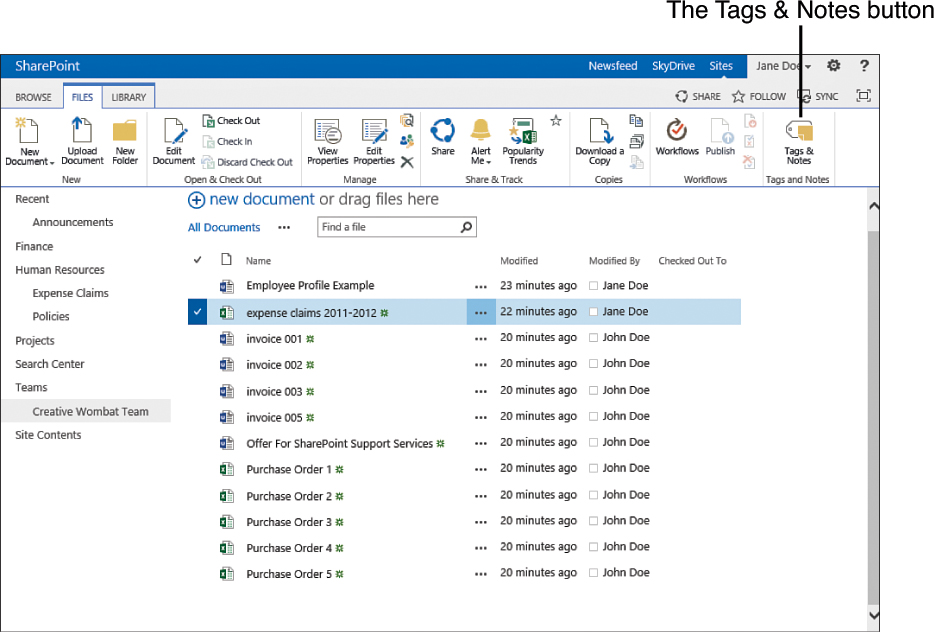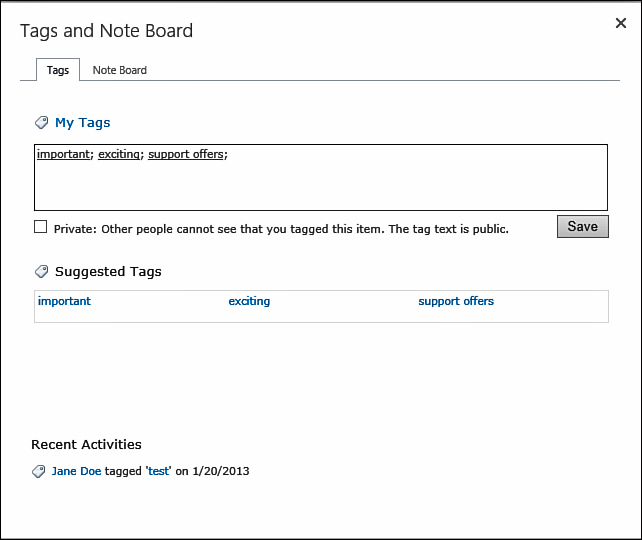Scenario/Problem:
You find that a specific document, list item, or page is useful to you,
and you want to be able to mark it so that you can easily find it in
the future. You might also want to share this mark with other people.
Solution: Tagging is a useful mechanism that helps you find content quickly. This
mechanism is available only in SharePoint 2013 Server, not in SPF.
Tip
Tagging is not just for highlighting
something as useful. It has many different uses! For example, you might
want to tag some documents and items as “unhelpful,” or “redundant,” or
maybe “not relevant.” Doing so will allow you to compile a list of
documents that you think should be removed, and you can then report
them to the site manager.
When tagging an item, you can write basically
anything that you want that will help you find that item later on.
Then, when you go to your personal site, you can see the phrases that
you used, and the documents you tagged with those phrases. You will
also be able to use the tags when searching for documents, items, and
pages. Tagging can target a document, a list item, a page, or even sites—including external sites.
For example, if you tag
two documents in different sites with the phrase “my important
presentations,” and another document with the phrase “a template for
invoices,” when you go to your personal site, you will have a page
showing you the two phrases, and when you click on one of them, you see
links to the documents you tagged with that phrase.
To tag an item or a file with a different phrase, you select the row for that document or item and switch to the Files ribbon. In the ribbon, you will see the Tags
& Notes button, as shown in Figure 1.

FIGURE 1 After selecting a single document, you can click on the Tags & Notes button.
After you click the Tags & Notes button,
a window appears, showing the tags that you and other users have
attached to the document or item (see Figure 2).

FIGURE 2. The tagging dialog, showing the Tags tab.
To write a tag, you type the tag’s text in
the text box and click Save. Alternatively, you can click on a tag from
the Suggested Tags list at the bottom of the dialog to quickly add tags
that you or others have used in the site most frequently. You can add
separate tags by using the semicolon character to separate them. For
example, writing “Important; Exciting” tags the item with the two
separate words Important and Exciting. The My Tags
box at the top shows the tags that are already set on the file or item.
You can choose to make a tag private so other people will not see it.
When you click Save, the tags you added
become underlined to signify that they have been added. You can close
the dialog by clicking the X button in the top-right corner. When
you open the dialog again, you see the same tags, and the Recent
Activities list on the bottom of the dialog shows the date you added
the tags.
Tip
Tagging a page in SharePoint is possible, but
not all pages show the buttons that allow you to tag it. Pages that do
allow this usually have the buttons as part of the navigation ribbon.
If you cannot find the link, you can still tag the page by using the
instructions in the following section.